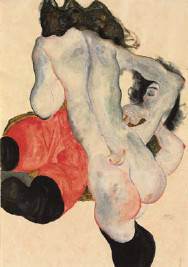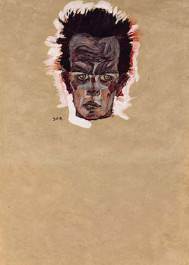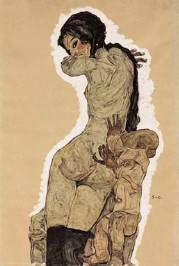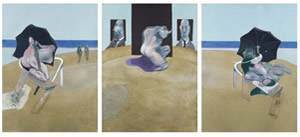
Egon Schiele (1890-1918)
Liegende Frau mit roter Hose und stehender weiblicher Akt, 1912
(estimado: £2,000,000-3,000,000)
>
Egon Schiele (1890-1918)
Selbstbildnis, Kopf (recto), 1910; Porträt Hans Massmann (verso), 1909
(estimado: £700,000-1,000,000)

Egon Schiele (1890-1918)
Mutter und Kind, 1910
(estimado: £1,500,000-2,000,000)
EIGHT MAJOR WORKS BY EGON SCHIELE TO BE OFFERED AT CHRISTIE’S LONDON IN FEBRUARY 2008 One of the most important expressionist painters, major works by Egon Schiele (1890-1918) rarely appear in the Art market. Now, Christie’s is about to auction an impressive group of eight works by the artist. ]]>
January 13th 2008, source: Christie’s
An impressive collection of eight major works by Egon Schiele (1890-1918) will be offered in Christie’s Impressionist and Modern Art Evening Sale including Art of the Surreal on 4 February 2008. Estimated to fetch in excess of £7.6 million, the collection is being sold to benefit the Neue Galerie in New York.
Mutter und Kind, of 1910, marks a decisive turning point in Egon Schiele’s artistic and personal development (estimate: £1,500,000-2,000,000). It was in this year that the young artist would not only achieve a stylistic breakthrough in his art, but would also establish the universally compelling allegory of Mother and Child as an enduring theme in his work. Inspired in part by the monumental paintings of his mentor, Gustav Klimt, Mutter und Kind is one of Schiele’s earliest studies on the subject that, he believed, stood as a metaphor for the cycle of birth, life and death.
With their bruised colouring and waif-like forms, the figures in Liegende Frau mit roter Hose und stehender weiblicher Akt, 1912 (estimate: £2,000,000-3,000,000) indicate the vulnerability of human flesh, suggesting that the desire for love is tainted by the consciousness of our own mortality. Unlike other of his more provocative and explicit works depicting coupled women, in this gouache it is the hint of physical contact – the fact that it is an idea seemingly born only in the viewer’s mind – that lends the work much of its mystery and power.
For Schiele, the human figure was the main vehicle through which he conveyed both passion and belief. In Stehender Mann, executed in 1913, he has created an image that is filled with tensions, and these function on various levels of content and style (estimate: £1,500,000-2,000,000). As is so often the case in Schiele’s pictures of male figures, Stehender Mann acts as a form of self-portrait.
Painted in 1910, Selbstbildnis, Kopf (Self-Portrait, Head) is one of a series of self portraits that rank amongst Schiele’s finest achievements (estimate: £700,000-1,000,000). With his arresting gaze, Schiele stares out from the picture surface from Selbstbildnis (recto); Liegende Frau (verso) which was executed in 1914 (estimate: £800,000-1,200,000).
The collection also includes the charcoal on paper Mädchenakt mit pelzbesetztem (Mantel Girl in a Fur Coat), 1917 (estimate: £300,000-400,000); Sitzende Schwangere (Seated Pregnant Nude), circa 1910 (estimate: £400,000-600,000) and his 1917 portrait of Erich Lederer, the son of the Viennese industrialists August and Serena Lederer and one of Schiele’s most faithful friends and dedicated patrons of his art (estimate: £400,000-600,000).
Follow us on:


